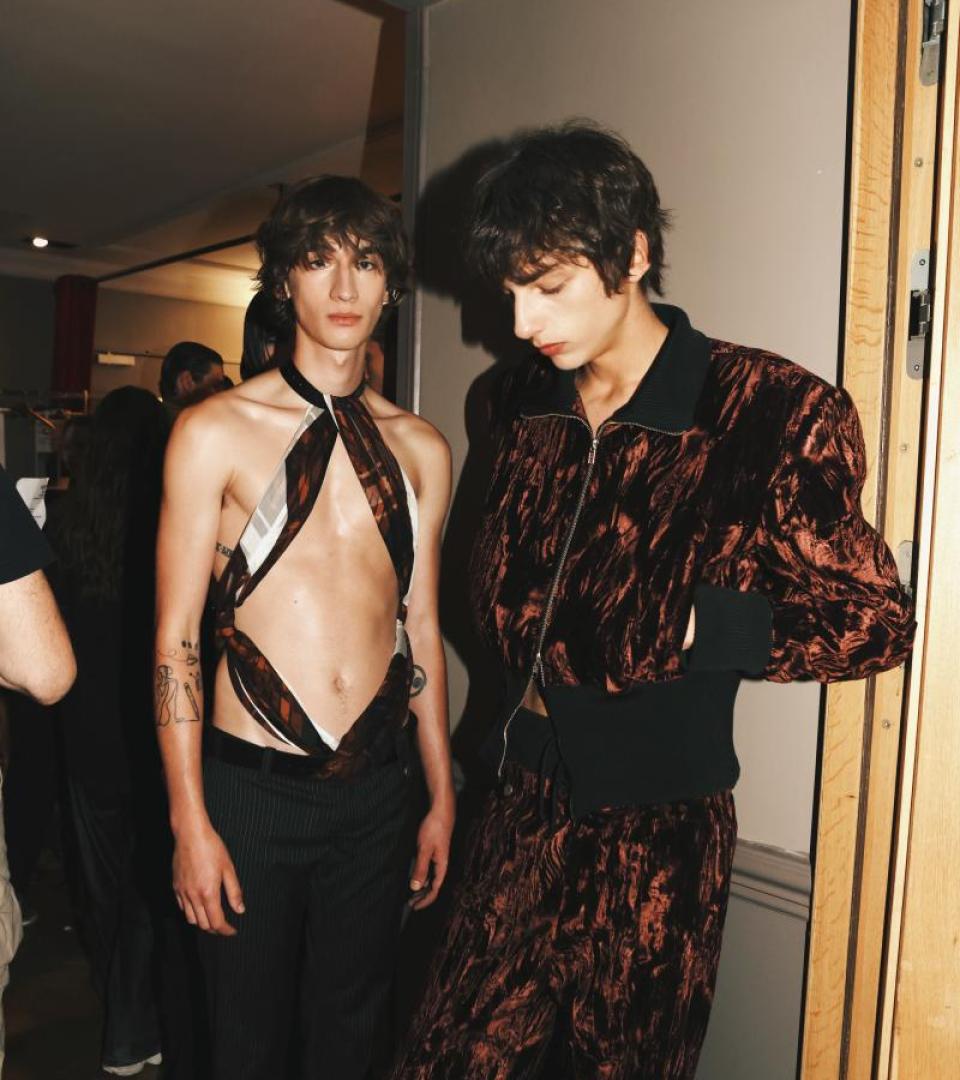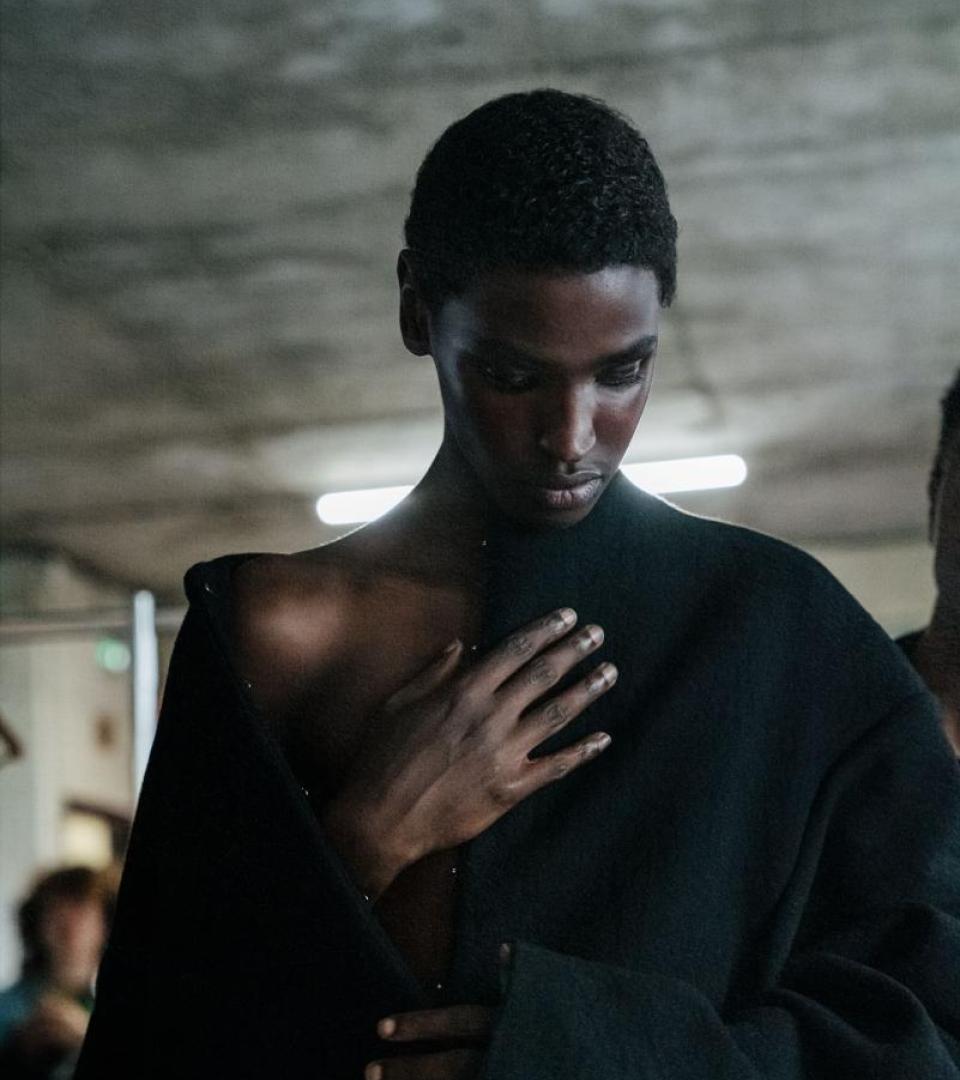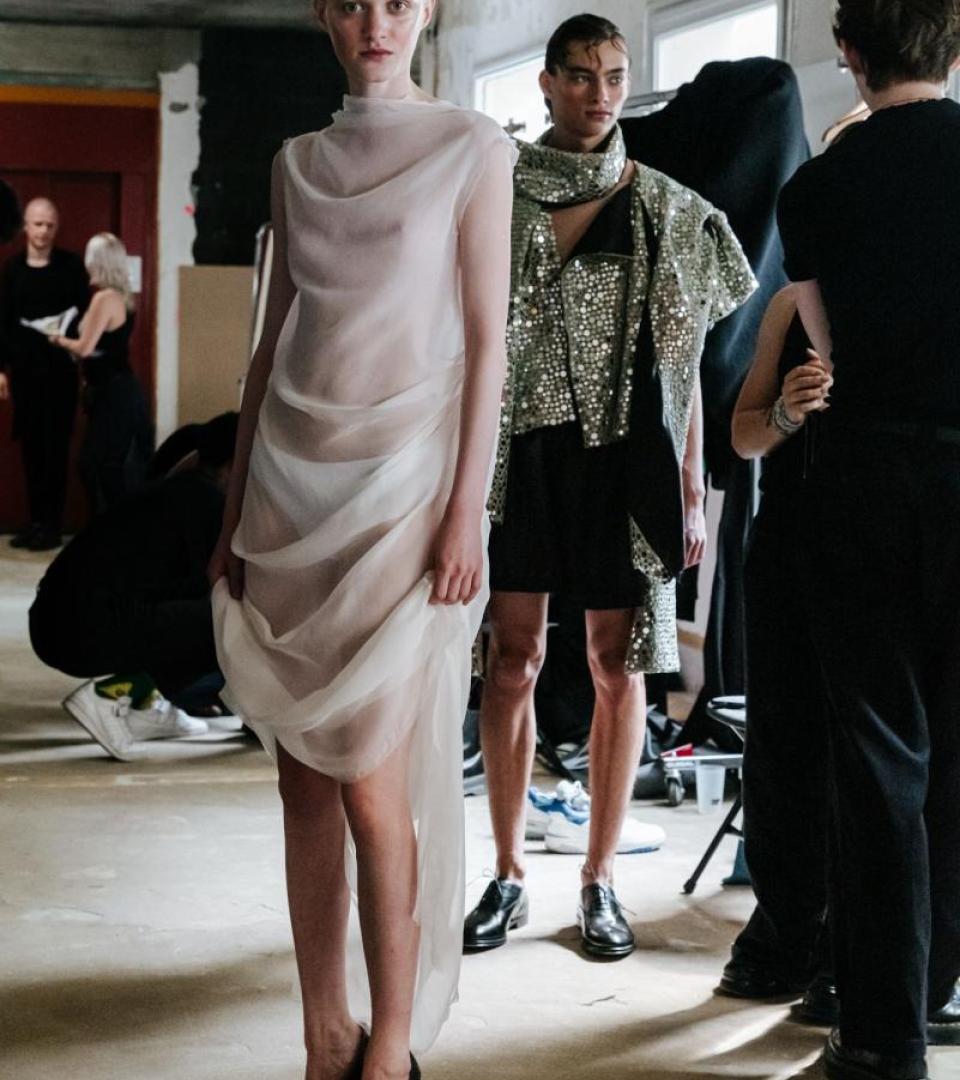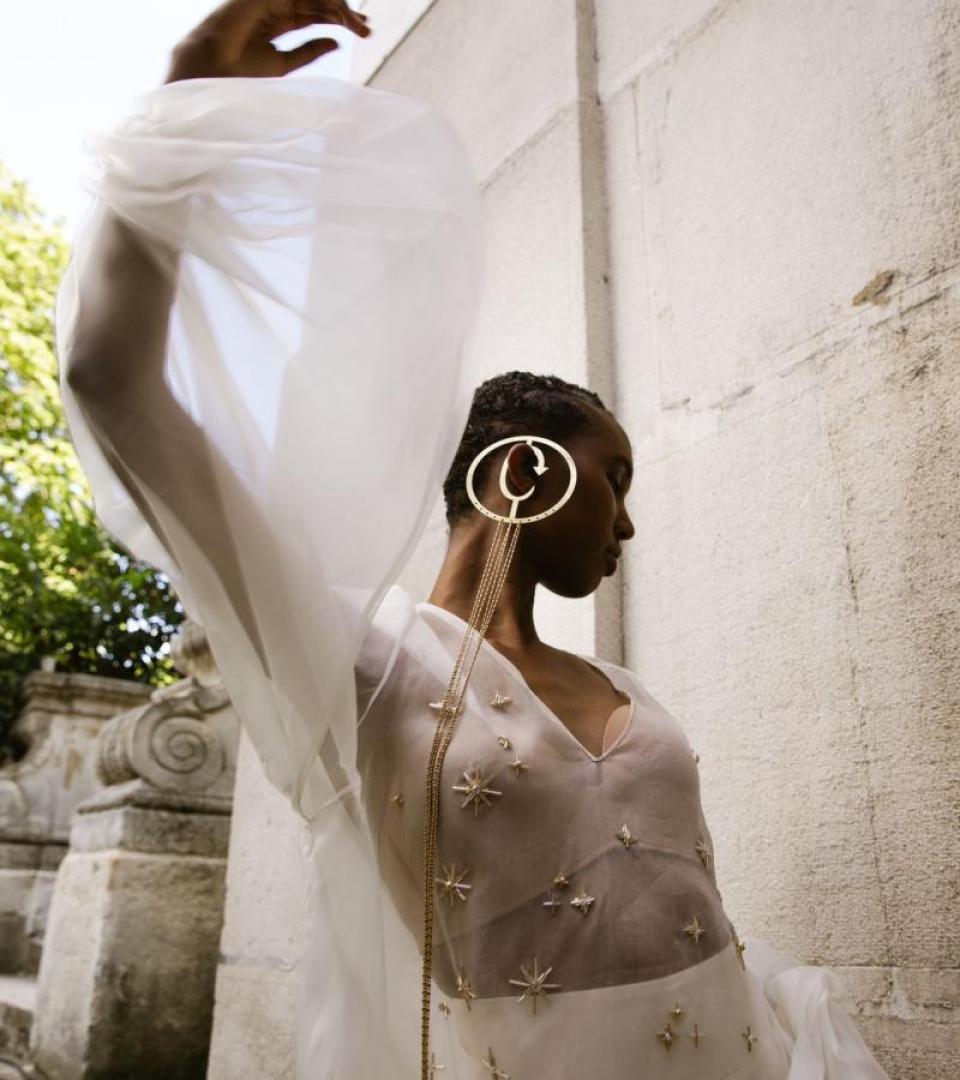Pascale Mussard: “The finalist designers of the Hyères Festival must be supported. It's the most important moment at the start of their career.”
Pascale Mussard's discretion masks a considerable influence on contemporary creation. As President of Villa Noailles since 2016, she has instilled in the Hyères Festival and the Design Parade the philosophy she developed with the “Petit h” line, launched at Hermès in 2010: To offer a space for expression to the most talented and innovative artisans and creatives. Surrounded by artists since childhood, seems to naturally attract devotees of beauty and fine craftsmanship.
Her bag overflows with books, like her humble, contained enthusiasm - a wave beneath a lid. Whenever Mussard senses herself in the limelight, she steps offstage. Throughout her career, she has championed creatives and learned from them. “I've never signed anything, neither text nor object. I love creating things with others. The creative director drives the vision, and without them everything collapses. The craftsman creates the object, imbues it with intelligence. One dreams and the other realises the dream. It's this exchange that moves me,” she explains. Her journey began in 1978, as an assistant to stylist, Nicole de Vésian, and her young right-hand man, Christian Lacroix. The following year, de Vésian was called in as a styling consultant at Hermès to strengthen the creative studio, then directed by Catherine de Károlyi. Mussard followed her, at a time when Hermès was pivoting its communication strategy: “Back then, Hermès, as a House of craftsmanship, communicated only through its window displays designed by Annie Beaumel,” she explains. To lead this transformation, Françoise Aron and Pacha Bensimon, co-founders of the Eldorado agency which became Publicis EtNous, called upon Jean-Jacques Picart. He and Mussard then worked hand in hand, him on the outside, her on the inside of the House. This press attaché-turned-consultant and legendary talent scout became her mentor. “He trained me and I owe him a lot. There were only young designers around him: Thierry Mugler, Claude Montana, Jean-Rémy Daumas, Popy Moreni, Jean-Charles de Castelbajac...”, she recalls with a wry smile, well aware of the monumental legacy of these talents who were just starting out. “I was impressed by their boldness. I was very shy and they didn't know me, but I listened to their discussions. I knew them better than they might have thought.”
As time went on, she kept on refining her approach to beautiful objects. “The project that frightened me most was when Yohji Yamamoto asked me to design a bag.” Following extensive discussions, she went with Irène Silvagni - former fashion editor-in-chief of Vogue Paris who had been working with Yohji since 1981 - to the designer's office “which was like an attic” to present a prototype. “I was terrified of disappointing him and when I opened it... He took me in his arms. He loved it.” He ordered fifteen models in Barénia leather for his show on 25 February 2008 - his Fall-Winter 2008/2009 collection. “It was Juan Iniguez, a craftsman I adored, who had made the strap.” In 2010, this quest for shared creation with artisans culminated in the launch of the “Petit h” line, where workshop offcuts are transformed into unique objects thanks to the exceptional savoir-faire of Hermès hands. “A craftsman, Arnaud Philippe, spoke of 'sleeping materials'. We never talked about waste.” This proximity with artisans nourishes her entire approach: “I learned everything by putting my desk in the workshop, with the craftspeople who make things. The project came to life thanks to Mickael Orain and his exceptional expertise. He was working in the bespoke orders department.” The first craftsman of “Petit h”, Orain was also awarded Meilleur Ouvrier de France (for leather goods, obviously) in 2019. “Some objects became 100 times better, 100 times more intelligent because the craftspeople explained that certain techniques could make them lighter, or stronger.” Materials are reinvented, forms multiply, possibilities open up. “When I was a child, I used to go into the workshops, I would pick up scraps of leather... that's where it comes from, Petit h. It's the laboratory.”
"Throughout my professional life, I lacked self-confidence. But with the difficulties we experienced at Villa Noailles, I realised that one can be stronger than one thinks, stronger than I think."
In 2016, she succeeded Didier Grumbach as President of Villa Noailles. “I only accepted because Didier asked me to and it wasn't supposed to last long. He supported me greatly, as did Marie-Claude Beaud and Stéphane Wargnier who has always guided and encouraged me. These roles require strategic sense, political acumen, and I don't have that. I never will.” Yet for nearly ten years now, she has fulfilled this role in her own way, with gentleness. She already knew Villa Noailles inside out, as President of the Friends of Saint-Bernard association, founded in 2008 to support the venue and its cultural projects. And long before that, as a child, when she would visit with her father. “He was an architect and passionate about Robert Mallet-Stevens, the Villa's architect.” Perched on the slopes of Castéou hill in Hyères, it is a poetic and labyrinthine place. “There's even a room with a staircase that leads nowhere,” she notes with a smile. In 2022, her commitment to supporting creation earned her the Order of Arts and Letters, a distinction she never dared to collect. “I've never spoken about it because I don't think I deserve it. I only owe it to the people who carried me, and I would like to receive it from Didier Grumbach's hands, in the presence of my three children.”
The 40th edition of the Festival will take place from Thursday, October 16th through Saturday the 18th, and opens a new chapter with the arrival of Hugo Lucchino as director, who was appointed last July. General Secretary of the Palais Galliera since 2020 and formerly at the Centre national du graphisme, he joins the Villa to structure and support its development. “What I appreciate in Hugo’s vision is his commitment to carrying forward the project of transmission and support initiated by Jean-Pierre Blanc, who, together with his teams, has accomplished remarkable work over the past four decades. We owe him much for this unique and visionary initiative dedicated to young creation.” The anniversary edition remains true to the mission of revealing and nurturing emerging talents whilst respecting the historical and poetic heritage of Marie-Laure and Charles de Noailles. “I think of designers who were finalists without winning the competition, and who are now established names, or others who have joined major institutions. The craftspeople and designers who reach the finals of the Hyères Festival must be supported. It's the most important moment at the start of their careers.” A commitment that the Villa Noailles has always championed and which endures despite the turbulence.
“In creation, dreaming is universal. You can't buy everything but you can dream of having something.”
This sensitivity for exceptional craftsmanship and its transmission, which is an integral part of her, is reflected in her other projects. She thus supports the Ivan Honchar Museum in Kyiv, Ukraine. “It's the story of a family who preserved vernacular objects, embroideries... it's magnificent. I support them personally so they can photograph the works and archive them in what will be a fascinating book. I'm very attached to these people and what they do, especially since the war began,” she shares with emotion.
Her commitment also extends to Uzbekistan, a country she has known since 1973, when she went there as a student to discover textiles. Decades later, in Milan, she recognized in photographs from the Biennale the places she had visited in her youth. This long-standing attachment naturally led her to personally support the Namuna artist residency in Tashkent. “I visited the extraordinary workshops of embroidery, drawing, carpets, miniatures. The principle of artist residencies is wonderful. They have a year of total freedom to create. A new international call for applications will be launched soon.”
Whether traditional craft or contemporary creation, this desire for transmission also leads her to extend her support to fashion designers by sitting on the jury of AZ Academy, a 12-month programme launched in 2024 by Richemont in collaboration with Accademia Costume & Moda in Milan led by Lupo Lanzara and whose academic programmes are directed by Barbara Trebitsch. “Mauro Grimaldi, who ran AZ Factory with Alber Elbaz, called me to ask if I would join the jury.” Alongside seventeen other industry professionals, including Isabel Marant, Lutz Huelle and Sara Sozzani Maino, she guides young emerging designers in their complete learning of creative entrepreneurship. "They're taught to engage with the fashion industry world, from communication to business, retail and investment."
A true tour de force she has never lost the kindness and fragile hope of childhood - a shield against external storms. Perhaps the lack of confidence allows for perspective, for doubt, for never being too firmly rooted in oneself. A quiet strength she carries without thought, devoted to supporting and championing others.
Reuben Attia



